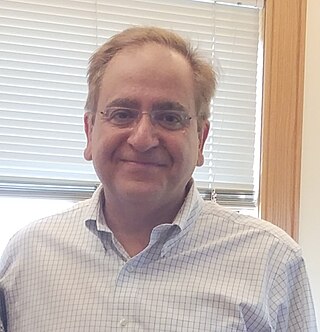Related Research Articles
In physics, string theory is a theoretical framework in which the point-like particles of particle physics are replaced by one-dimensional objects called strings. String theory describes how these strings propagate through space and interact with each other. On distance scales larger than the string scale, a string looks just like an ordinary particle, with its mass, charge, and other properties determined by the vibrational state of the string. In string theory, one of the many vibrational states of the string corresponds to the graviton, a quantum mechanical particle that carries the gravitational force. Thus, string theory is a theory of quantum gravity.

Edward Witten is an American mathematical and theoretical physicist. He is a Professor Emeritus in the School of Natural Sciences at the Institute for Advanced Study in Princeton. Witten is a researcher in string theory, quantum gravity, supersymmetric quantum field theories, and other areas of mathematical physics. Witten's work has also significantly impacted pure mathematics. In 1990, he became the first physicist to be awarded a Fields Medal by the International Mathematical Union, for his mathematical insights in physics, such as his 1981 proof of the positive energy theorem in general relativity, and his interpretation of the Jones invariants of knots as Feynman integrals. He is considered the practical founder of M-theory.

Pierre René, Viscount Deligne is a Belgian mathematician. He is best known for work on the Weil conjectures, leading to a complete proof in 1973. He is the winner of the 2013 Abel Prize, 2008 Wolf Prize, 1988 Crafoord Prize, and 1978 Fields Medal.
In algebraic geometry and theoretical physics, mirror symmetry is a relationship between geometric objects called Calabi–Yau manifolds. The term refers to a situation where two Calabi–Yau manifolds look very different geometrically but are nevertheless equivalent when employed as extra dimensions of string theory.

Cumrun Vafa is an Iranian-American theoretical physicist and the Hollis Professor of Mathematics and Natural Philosophy at Harvard University.

Yuri Ivanovich Manin is a Russian mathematician, known for work in algebraic geometry and diophantine geometry, and many expository works ranging from mathematical logic to theoretical physics. Moreover, Manin was one of the first to propose the idea of a quantum computer in 1980 with his book Computable and Uncomputable.
Homological mirror symmetry is a mathematical conjecture made by Maxim Kontsevich. It seeks a systematic mathematical explanation for a phenomenon called mirror symmetry first observed by physicists studying string theory.
John Willard Morgan is an American mathematician known for his contributions to topology and geometry. He is a Professor Emeritus at Columbia University and a member of the Simons Center for Geometry and Physics at Stony Brook University.

Jürg Martin Fröhlich is a Swiss mathematician and theoretical physicist. He is best known for introducing rigorous techniques for the analysis of statistical mechanics models, in particular continuous symmetry breaking, and for pioneering the study of topological phases of matter using low-energy effective field theories.

Nikita Alexandrovich Nekrasov is a mathematical and theoretical physicist at the Simons Center for Geometry and Physics and C.N.Yang Institute for Theoretical Physics at Stony Brook University in New York, and a Professor of the Russian Academy of Sciences.

Richard Paul Winsley Thomas is a British mathematician working in several areas of geometry. He is a professor at Imperial College London. He studies moduli problems in algebraic geometry, and ‘mirror symmetry’—a phenomenon in pure mathematics predicted by string theory in theoretical physics.
Daniel Stuart Freed is an American mathematician, specializing in global analysis and its applications to supersymmetry, string theory, and quantum field theory. Since 1989, he has been a professor at the University of Texas at Austin.
Sheldon H. Katz is an American mathematician, specializing in algebraic geometry and its applications to string theory.

Victor Vadimovich Batyrev is a Russian mathematician, specializing in algebraic and arithmetic geometry and its applications to mathematical physics. He is a professor at the University of Tübingen.
Paul Stephen Aspinwall is a British theoretical physicist and mathematician, who works on string theory and also algebraic geometry.
Xenia de la Ossa Osegueda is a theoretical physicist whose research focuses on mathematical structures that arise in string theory. She is a professor at Oxford's Mathematical Institute.

Ralph Martin Kaufmann is a German mathematician working in the United States.

Kyōji Saitō is a Japanese mathematician, specializing in algebraic geometry and complex analytic geometry.
Carina Curto is an American mathematician, a professor at Pennsylvania State University, and a Sloan Research Fellow. She is known for her work on mathematical neuroscience, including the applications of mathematics in both theoretical and computational neuroscience. Her recent work is funded by the BRAIN Initiative. She is an associate editor at SIAGA, a SIAM journal on applied algebra and geometry and on the editorial board at Physical Review Research.
Mikhail Kapranov, is a Russian mathematician, specializing in algebraic geometry, representation theory, mathematical physics, and category theory. He is currently a professor of the Kavli Institute for the Physics and Mathematics of the Universe at the University of Tokyo.
References
- 1 2 David Robert Morrison at the Mathematics Genealogy Project
- ↑ Curto, Carina (May 6, 2005). "Matrix Model Superpotentials and Calabi-Yau Spaces: an ADE Classification". arXiv: math/0505111 .